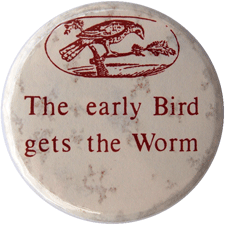Stock Market Video Selling Big Losers: How and Why
The Early Bird gets the Worm
Stock Market Video
Selling Big Losers: How and Why
The Early Bird Gets the Worm
In Case You Missed It
---
In this week’s Stock Market Video, Mike Cintolo, Editor of Cabot Market Letter and Cabot Top Ten Trader talks about the slow, steady improvement in the indexes and leading stocks, and draws an interesting comparison to 2006, when growth stocks kicked into gear a full two or three months after the indexes bottomed. It could be that something similar is happening this year. Stocks mentioned include: SolarWinds (SWI), Amazon.com (AMZN), Equinix (EQIX), Under Armour (UA), Western Digital (WDC) and more. Click below to watch the video!
Selling Big Losers: How and Why
Let’s say that in spite of your New Year’s resolutions, the good advice you’ve received from advisors and your sincere best intentions, you are sitting with a stock in your portfolio that represents a huge loss. Or maybe more than one.
Maybe you went on vacation during earnings season and one of your stocks reported badly and investors threw it off a cliff. Or maybe the stock has been drifting downhill for months, but you love the story and you’ve just been watching in disbelief, knowing that it will go back up. Or maybe you’re just angry that the stock has tanked and you’re just not going to capitulate. (After all, if you don’t sell it, it’s not a loss, right?)
There are a few ways to rationalize holding on to a big loser, but not many. A stock may be a core holding in your portfolio that pays a good dividend. It may be a value play and you have the fundamentals to support your long-term projections for its ultimate success. Or, maybe you’re postponing actually booking the loss to use to offset a big capital gain for tax purposes (the least likely scenario of all these days).
But chances are good that you’re holding onto this loss out of hope (misplaced), sadness (appropriate, but not a good guide to investing) or love of the stock itself. And believe me, any growth investor who’s been around the block a few times has been through all of those bad excuses, and more.
So my message today is that it’s time to kick those broken stocks to the curb and get on with your investing life. It’s not easy, but it will make you (and your portfolio) feel much better as soon as you do.
Why sell? There are three big reasons. First, you will protect yourself from further losses. (If you think the stock has gone as low as it can go, you’re probably wrong. A quick look at the charts of Green Mountain Coffee Roasters (GMCR) and Netflix (NFLX) over the past year will give you the idea in very graphic terms.)
Second, you will free up the remaining capital for use in owning a healthier stock with better growth prospects.
Third, and maybe most important, by biting this bullet you will help yourself to avoid repeating this mistake in the future. Chunking your big losers into the trash will help you to learn the lesson that hope, while can be part of a rationale for buying a stock, is a terrible, terrible reason to hold onto one. And having the gumption to jettison losses will reinforce your resolve to use appropriate loss limits in the future.
As far as how to sell, my advice is just to hit the dang “SELL” button! Yes, you can wait for a price uptick, but that often gives rise to the temptation to hold on in hopes that the stock will continue to recover. But big losers are often damaged, and true recovery may not occur for quarter after quarter. And if you’re worried that the stock might just blast off to the upside as soon as you sell it, ask yourself this question: Is it more likely that your wounded bird of a stock will rally, or that a fresh new stock in an uptrend will? If your brain-housing module is in good working order, I think you’ll make the right decision.
---
Here’s this week’s Contrary Opinion Button. Remember, you can always view all of the buttons by clicking here.
The early Bird Gets the Worm
This proverb dates back to the 17th century--perhaps farther--and its value then is obvious. He who rose at dawn (or before) had first crack at the opportunities of the day.
Today, with electricity enabling productive activity 24 hours of the day, some argue that the proverb is less relevant. As an early riser, I like it. (Editor’s note: Even in an electric age, some diligent investors find great opportunities before others catch on. But there’s also a danger in over-eagerness. That’s why one of my favorite cynical proverbs is “The early bird gets the worm, but the second mouse gets the cheese.”
---
In case you didn’t get a chance to read all the issues of Cabot Wealth Advisory this week and want to catch up on any investing and stock tips you might have missed, there are links below to each issue.
Cabot Wealth Advisory 8/13/12 — Six Things the Olympics Taught Me
In this issue, Tim Lutts, editor of Cabot Stock of the Month, reviews the lessons that the Olympic games taught him and explores the superiority of long-term stock market returns over bond yields. Stock discussed: Five Below (FIVE).
---
Cabot Wealth Advisory 8/16/12 — Ten Lessons I’ve Learned from the Experts
In this issue, Chloe Lutts, who edits Dick Davis Investment Digest and Dick Davis Dividend Digest, reviews some of her favorite lessons gleaned from interviews with various newsletter editors over the last six months.
Have a great weekend,
Paul Goodwin
Editor of Cabot Wealth Advisory



